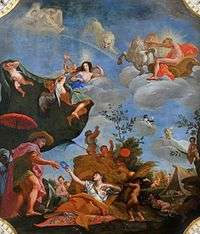Plafond

Plafond Allegory of Summer by Jerzy Siemiginowski-Eleuter, 1684–86, oil on canvas and panel, Wilanów Palace, Warsaw.[1]
A plafond (French for "ceiling"), in a broad sense, is a (flat, vaulted or dome) ceiling.
A plafond can be a product of monumental painting or sculpture. Picturesque plafonds can be painted directly on plaster (as a fresco, oil, glutinous, synthetic paints), on a canvas attached to a ceiling (panel) or a mosaic.
As a decorative feature of churches and staterooms, plafonds were popular from the 17th century until the beginning of the 19th century. Designs of this period typically used the illusion of a break in the ceiling showing the architectural structure behind, strongly foreshortened figures, architectural details and/or the open sky.
References
- ↑ (in English) "The King's Bedroom". wilanow-palac.art.pl. Retrieved 21 February 2008.
This article is issued from
Wikipedia.
The text is licensed under Creative Commons - Attribution - Sharealike.
Additional terms may apply for the media files.